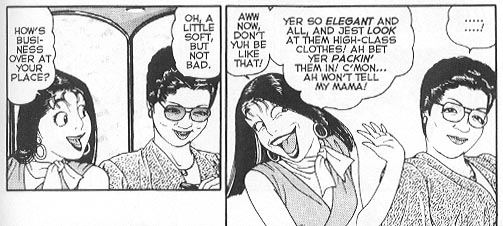 By Makoto Kobayashi
By Makoto Kobayashi
192 pages, black and white
Published by Dark Horse
It’s been a little over two years since the last collected volume of Club 9, and reading this latest set of installments reminded me once again why I love it so much. Makoto Kobayashi’s probably better appreciated for his hysterical What’s Michael? series, but if you’re skipping Club 9 because it doesn’t feature dancing cats, you’re really missing out.
Haruo Hattori works in the Ginza at Club 9, one of the most happening hostess bars. She and the other new ladies of Club 9 are just what lonely businessmen of all shapes and sizes are looking for; funny, attractive, pleasant women to hang out with while having drinks. It makes good money for Haruo so she can afford her apartment and go to college in the big city of Tokyo, instead of languishing on her rural farm home. What Haruo wasn’t expecting, though, was for the number of patrons from Club 9 to fall head-over-heels for her… and how her life’s about to get a lot more confusing as a result!
A book about a country girl working in the Ginza could very easily fall into the category of sleazy, and I think one of the parts of Club 9 that makes it so interesting is its determination to never do so. Haruo and the other girls of Club 9 aren’t sullied by their time working at a hostess bar; instead they remain genuinely nice women who provide a service to people who are lonely for whatever reason. (Interestingly enough, one short story by Kobayashi in What’s Michael? shows the other, more popularly depicted side of the Ginza with a businessman getting ripped off by a hostess bar in the Ginza, so it’s certainly a case of Kobayashi deciding what side of the social phenomenon is appropriate for the stories he wants to tell.) Haruo is of course the center of Club 9 and it’s her charm that carries so much of the series. From thinking that the president of manga publisher “Kodandansha” is the manager of a hostess bar, to her perplexed reaction to being gifted with a Ferrari for her 19th birthday, she’s got a certain innocence about her which manages to be cute rather than annoying. She’s the ultimate “good girl” of comics, always thinking the best of her clients and going through life with a smile on her face. In lesser hands it’d drive readers to want to strangle her, but Kobayashi (and translators Dana Lewis and Toren Smith) manage to keep Haruo appealing. With only five volumes of Club 9 in Japan, it’s easy to see that we’re at the halfway point, with Haruo’s personal life coming once more to a head and the question of just what her future will hold becoming more interesting. Even as she begins to receive what many would consider better offers than her boyfriend back at home, Kobayashi makes you hope both that she’ll end up with someone else and with the one she’s staying faithful to. Now that’s a feat.

Kobayashi’s art for Club 9 remains unchanged, a slightly over-the-top, pleasant style. It’s funny to look at the girls of Club 9 with their kabuki mask styled faces and expressions, their grins forever fixed outwards. There’s a lot of physical comedy going on here too, from the manga art assistants’s bulging eyes and dumbfounded expressions when Haruo stops by the studio to give a pep talk, to the leering Grampy who manages to slip Haruo a check in a most inappropriate place. Best of all, though, is the serene smile that the head of Kodandansha gives Haruo even as Haruo tries to offer up a plate of sushi and ask how business is coming along. It makes the scene nothing short of perfect, achieving what the script alone couldn’t.
Club 9 is adorable, but so far as I can tell, critically ignored. It’s a shame because this is just fun, pure and simple. Hopefully now its publishing schedule is back on track, because this is a series that really deserves to get in the hands of a larger audience. Let’s see those final two volumes soon, please!
Purchase Links:
